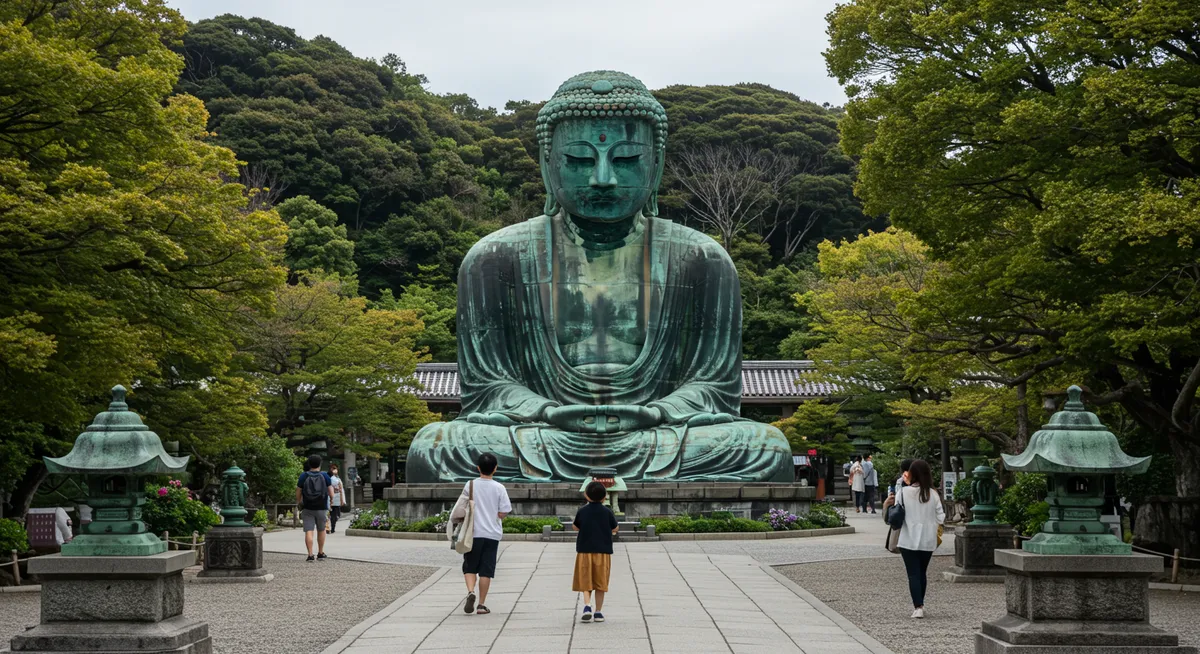
Your Essential Kamakura Great Buddha Visitor Guide
Table of Contents
Want to find the best travel deals for this destination? Chat with our travel hacking specialist!
Get Travel HacksCategory: kamakura-great-buddha-kotokuin-visitor-guide
Explore the Kamakura Great Buddha (Kotoku-in)
Having explored Japan extensively over the years, I've found few sights as profoundly impactful as the Kamakura Great Buddha, or Daibutsu, at Kotoku-in Temple. This colossal bronze statue is not just an artistic marvel but a spiritual centerpiece of Kamakura. This comprehensive Kamakura Great Buddha (Kotoku-in) visitor guide is designed to help you make the most of your journey to this magnificent landmark, ensuring a smooth and memorable experience. For broader travel insights, explore our main Plan Vacation Asia site.
Getting to the Great Buddha (Kotoku-in)
Reaching the magnificent Kamakura Great Buddha (Kotoku-in) is quite straightforward, making it an accessible highlight of any Kamakura visit. Most visitors arrive via Hase Station on the Enoden Line, which is just a 7-10 minute walk from the temple grounds. From Kamakura Station, you can easily catch the Enoden train, or opt for a local bus (Keikyu or Enoden bus) directly to the Daibutsu-mae bus stop, which is even closer. I've always found the Enoden ride particularly charming, offering scenic coastal views. For detailed routes and tips on how to get to Kamakura from Tokyo, consult our dedicated transport guide. Taxis are also available from Kamakura Station if convenience is a priority.
Opening Hours & Admission Fees
Planning your visit to the Kamakura Great Buddha (Kotoku-in) requires knowing the operational details to avoid surprises. The Kotoku-in temple grounds are typically open daily from 8:00 AM to 5:30 PM (until 5:00 PM from October to March), though it's always wise to check their official website for the most current information, especially during holidays. Admission to see the colossal bronze statue usually costs a modest fee, which is often around 300 JPY for adults. Additionally, for a small extra charge, you can even enter inside the Daibutsu itself, a unique experience I highly recommend for a sense of its immense scale. This internal view offers a fascinating perspective on its construction.
Best Time to Visit & What to Expect
To truly appreciate the Kamakura Great Buddha (Kotoku-in) in a serene setting, timing your visit is key. Early mornings, just after opening, or late afternoons are generally less crowded. My personal tip is to aim for a weekday if possible. Weekends and national holidays can see significant tourist numbers, especially around the impressive bronze statue. The Daibutsu stands majestically outdoors, so prepare for varying weather conditions. Expect a peaceful, reverent atmosphere within the temple complex, allowing you to reflect on this profound historical and spiritual landmark. For more on seasonal travel, see our guide on the best time to visit Kamakura.
Exploring Kotoku-in & Nearby Sights
Your Kamakura Great Buddha (Kotoku-in) visit extends beyond just the iconic statue. The Kotoku-in temple grounds themselves are beautifully maintained, featuring a serene garden and a small, informative museum. Once you've spent time with the Daibutsu, you're perfectly positioned to explore other significant Kamakura attractions. Hasedera Temple, famous for its Kannon statue and beautiful gardens, is just a short walk away. Beyond that, the bustling Komachi-dori Street offers souvenirs and local delicacies, providing a lively contrast. For a comprehensive overview of the city's highlights, refer to our full Kamakura travel guide or consider a structured Kamakura day trip itinerary from Tokyo for 2025.
Frequently Asked Questions
How long does it take to see the Kamakura Great Buddha?
Is the Kamakura Great Buddha wheelchair accessible?
What's the best way to combine the Great Buddha with other sights?
The Kamakura Great Buddha (Kotoku-in) stands as a testament to Japan's rich history and spiritual depth, offering a profound experience for all visitors. By following this Kamakura Great Buddha (Kotoku-in) visitor guide, you're well-equipped to navigate the temple grounds, appreciate its grandeur, and integrate it seamlessly into your wider Kamakura exploration. This iconic Daibutsu is more than just a statue; it's a window into Japan's enduring cultural heritage. Plan your trip today and prepare to be awe-struck by this magnificent landmark.